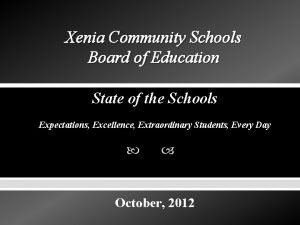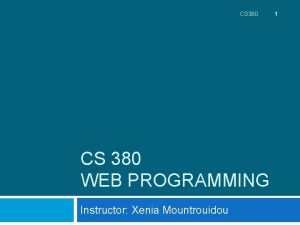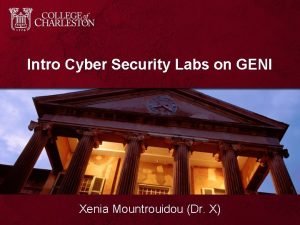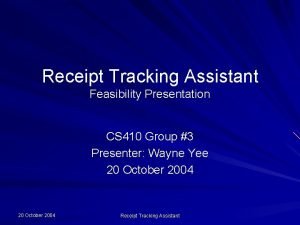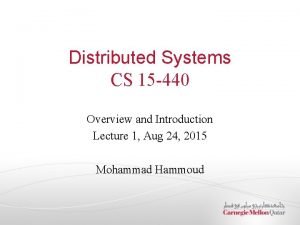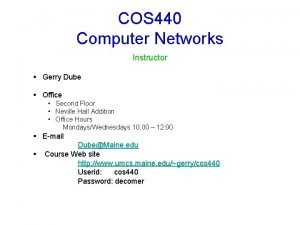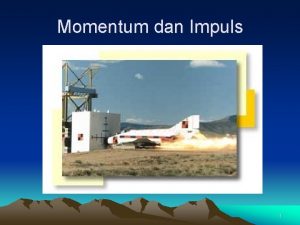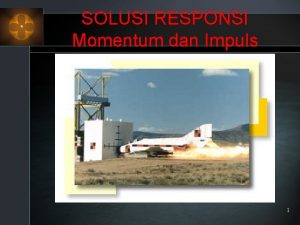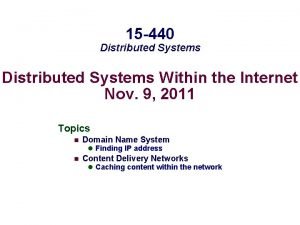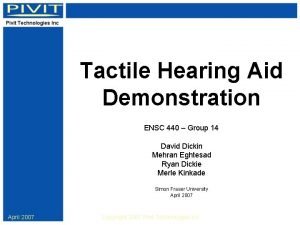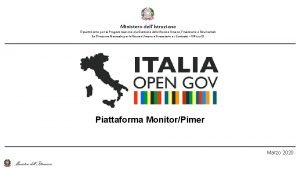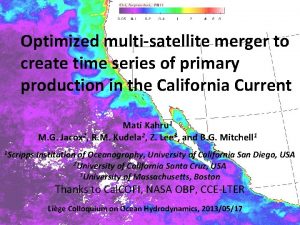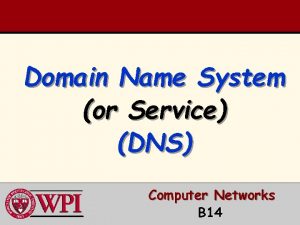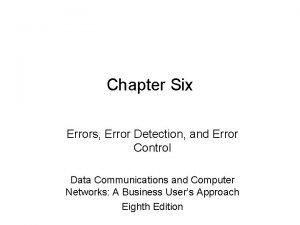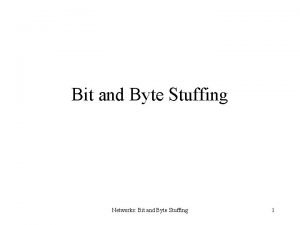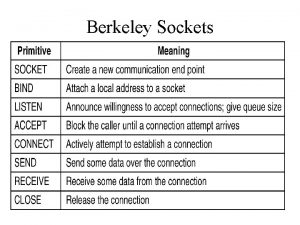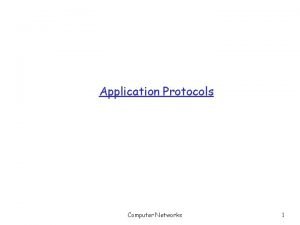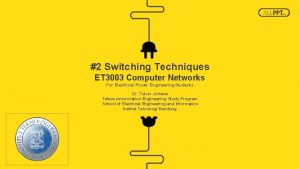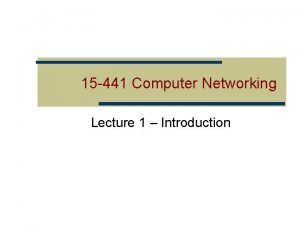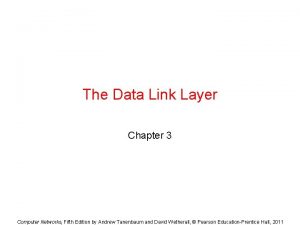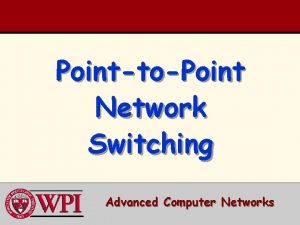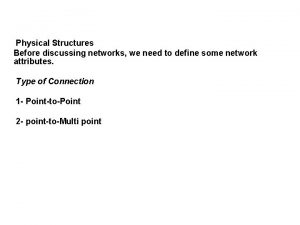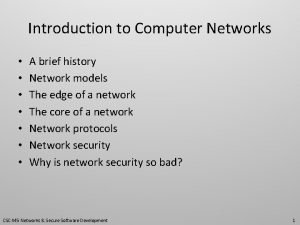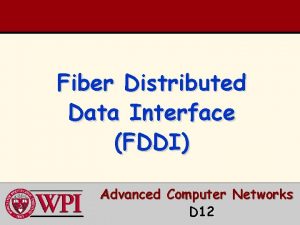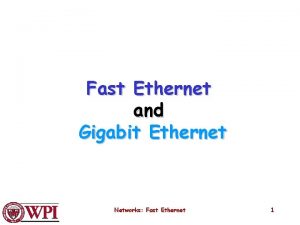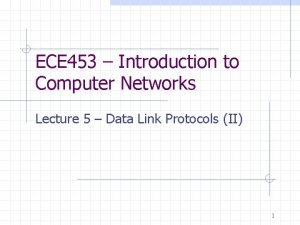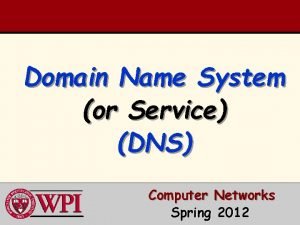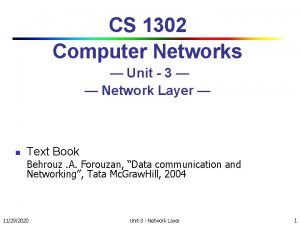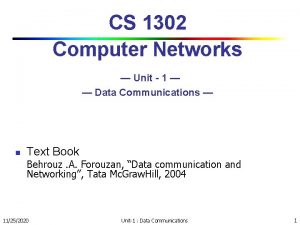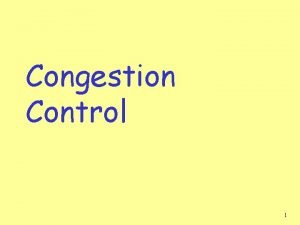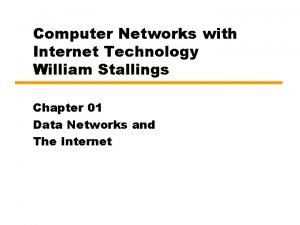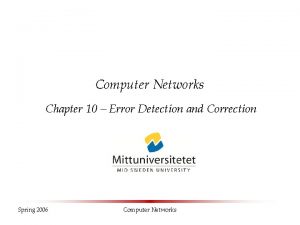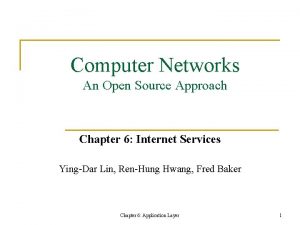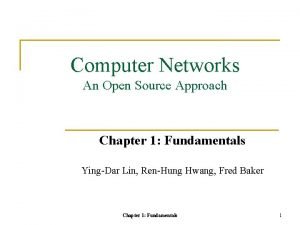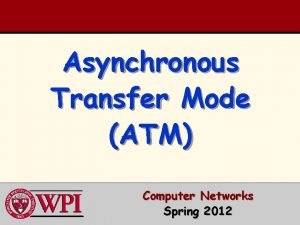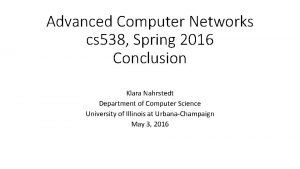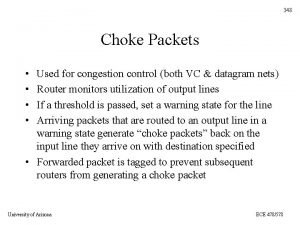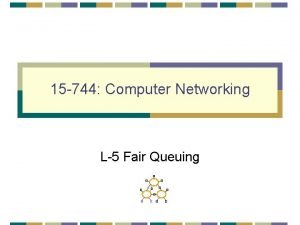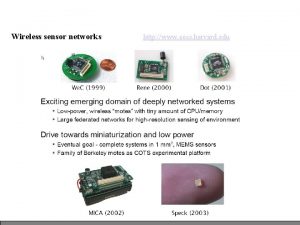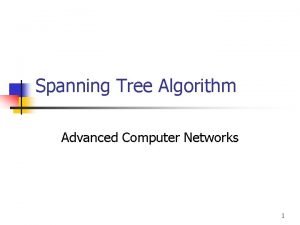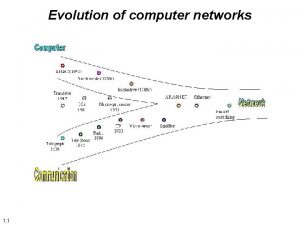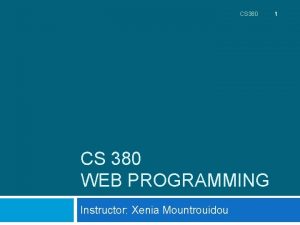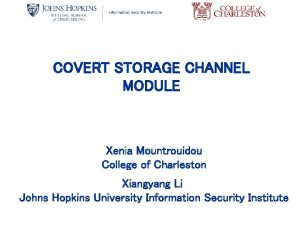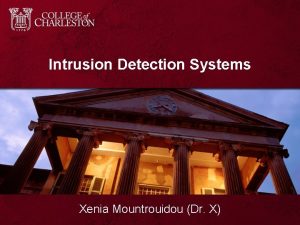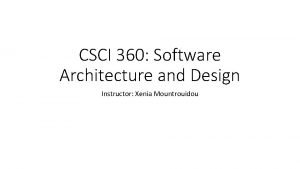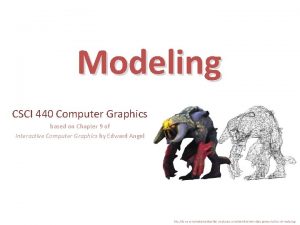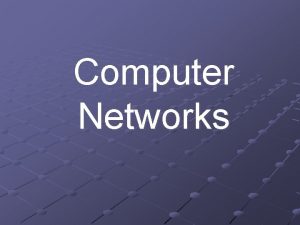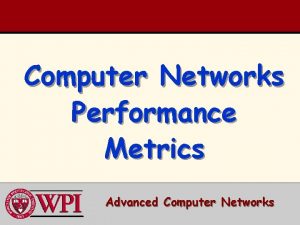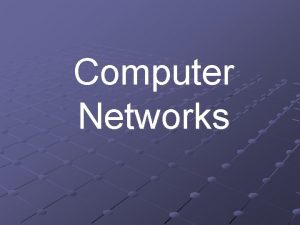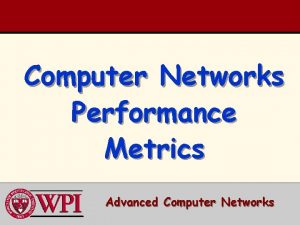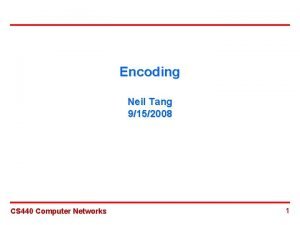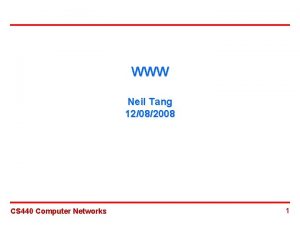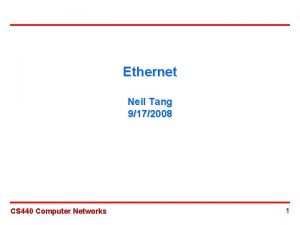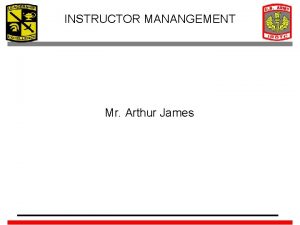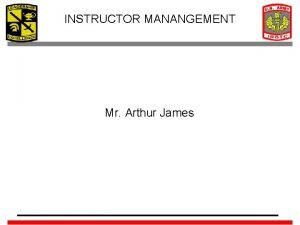CSCI 440 Computer Networks Instructor Xenia Mountrouidou Who






























































































- Slides: 94

CSCI 440: Computer Networks Instructor: Xenia Mountrouidou

Who am I? • Dr. X – Computer Scientist • Ph. D at North Carolina State University – Optical networks performance • Worked at IBM – Software Performance Engineer • Post doc at College of William and Mary – research on performance and power savings for hard disk drives • Assistant professor at Jacksonville University, Wofford College • Assistant professor at College of Charleston • Scuba diver, manga comics collector, science fiction reader, hacker 2

Who am I? 3

Outline • Class organization • How to survive this class • Project kickoff • Kahoot! • Intro to computer networks: big picture

Class Organization Objectives Lectures Grading Honor Code

Outcomes After completing CSCI 440 students will be able to: • Analyze computer network communication protocols. • Develop tools and reproduce protocols for network communication. • Evaluate the performance of a computer network based on queueing theory and statistics. • Communicate using technical writing.

Assumptions for this Class • Assumption: • You can develop a complete software artifact in Python or Java or C/C++ • You understand basic statistics and algebra • You have had practical experience with command line – if not, look at the links webpage and study the recommended tutorials! • Beneficial: • You understand how an operating system works

Grading Criteria Midterm 20% Final Project Homework Participation Total 20% 30% 20% 100%

Lectures • Slides: will not substitute for your reading • Discussion: answer questions, some kahoot quizzes (participation grade) • Labs/Exercises • Wireshark – packet of the week lab • GENI labs

Learning

Learning Aids Textbook Website resources Homework

Content • Public website – class content • Oaks – some overlapping content, submissions • Required textbook – required reading • Additional resources – links, interactive exercises

Syllabus • Mandatory reading • Ignorance of the rules does not exempt you from them

Honor code • Syllabus • Additional considerations for Computer Science courses: • Code • Collaboration

How to survive the class • Keep up with readings • Actively participate in lecture during class • Do not miss more than necessary classes • Work hard on the project • Ask questions • Visit me during office hours (or setup an appointment)

Project kickoff • Find teammates • Read project description • Start thinking about your topic!


Computer Networks… the Big Picture Slides adopted from: Computer Networks: A Top-Down Approach, Kurose & Ross, 7 th Edition

Chapter 1: introduction our goal: • get “feel” and terminology • more depth, detail later in course • approach: • use Internet as example overview: • what’s the Internet? • what’s a protocol? • network edge; hosts, access net, physical media • network core: packet/circuit switching, Internet structure • performance: loss, delay, throughput • security • protocol layers, service models • history Introduction 1 -19

Chapter 1: roadmap 1. 1 what is the Internet? 1. 2 network edge • end systems, access networks, links 1. 3 network core • packet switching, circuit switching, network structure 1. 4 delay, loss, throughput in networks 1. 5 protocol layers, service models 1. 6 networks under attack: security 1. 7 history Introduction 1 -20

What’s the Internet: “nuts and bolts” view PC server wireless laptop • billions of connected computing devices: • hosts = end systems • running network apps mobile network global ISP smartphone § communication links • fiber, copper, wireless links radio, satellite wired • transmission rate: links bandwidth router § packet switches: forward packets (chunks of data) • routers and switches Introduction home network regional ISP institutional network 1 -21

“Fun” Internet-connected devices Web-enabled toaster + weather forecaster IP picture frame http: //www. ceiva. com/ Slingbox: watch, control cable TV remotely Internet refrigerator Tweet-a-watt: monitor energy use sensorized, bed mattress Internet phones Introduction 1 -22

What’s the Internet: “nuts and bolts” view • Internet: “network of networks” mobile network • Interconnected ISPs • protocols control sending, receiving of messages • e. g. , TCP, IP, HTTP, Skype, 802. 11 global ISP home network • Internet standards regional ISP • RFC: Request for comments • IETF: Internet Engineering Task Force institutional network Introduction 1 -23

What’s the Internet: a service view • infrastructure that provides services to applications: • Web, Vo. IP, email, games, ecommerce, social nets, … • provides programming interface to apps mobile network global ISP home network regional ISP • hooks that allow sending and receiving app programs to “connect” to Internet • provides service options, analogous to postal service institutional network Introduction 1 -24

What’s a protocol? human protocols: network protocols: • “what’s the time? ” • “I have a question” • introductions • machines rather than humans • all communication activity in Internet governed by protocols … specific messages sent … specific actions taken when messages received, or other events protocols define format, order of messages sent and received among network entities, and actions taken on message transmission, Introduction 1 -25

What’s a protocol? a human protocol and a computer network protocol: Hi TCP connection request Hi TCP connection response Got the time? Get http: //www. awl. com/kurose-ross 2: 00 <file> time Q: other human protocols? Introduction 1 -26

Chapter 1: roadmap 1. 1 what is the Internet? 1. 2 network edge • end systems, access networks, links 1. 3 network core • packet switching, circuit switching, network structure 1. 4 delay, loss, throughput in networks 1. 5 protocol layers, service models 1. 6 networks under attack: security 1. 7 history Introduction 1 -27

A closer look at network structure: • network edge: mobile network • hosts: clients and servers • servers often in data centers global ISP home network § access networks, physical media: wired, wireless communication links regional ISP § network core: • interconnected routers • network of networks institutional network Introduction 1 -28

Access networks and physical media Q: How to connect end systems to edge router? Introduction 1 -29

Access network: digital subscriber line (DSL) central office DSL splitter modem voice, data transmitted at different frequencies over dedicated line to central office telephone network DSLAM ISP DSL access multiplexer § use existing telephone line to central office DSLAM • data over DSL phone line goes to Internet • voice over DSL phone line goes to telephone net § < 2. 5 Mbps upstream transmission rate (typically < 1 Mbps) § < 24 Mbps downstream transmission rate (typically < 10 Mbps) Introduction 1 -30

Access network: cable network cable headend … cable splitter modem V I D E O V I D E O D A T A C O N T R O L 1 2 3 4 5 6 7 8 9 Channels frequency division multiplexing Introduction 1 -31

Access network: cable network cable headend … cable splitter modem CMTS data, TV transmitted at different frequencies over shared cable distribution network cable modem termination system ISP § HFC: hybrid fiber coax • asymmetric: up to 30 Mbps downstream transmission rate, 2 Mbps upstream transmission rate § network of cable, fiber attaches homes to ISP router • homes share access network to cable headend • unlike DSL, which has dedicated access to central office Introduction 1 -32

Access network: home network wireless devices to/from headend or central office often combined in single box cable or DSL modem wireless access point (54 Mbps) router, firewall, NAT wired Ethernet (1 Gbps) Introduction 1 -33

Enterprise access networks (Ethernet) institutional link to ISP (Internet) institutional router Ethernet switch institutional mail, web servers • typically used in companies, universities, etc. § 10 Mbps, 100 Mbps, 1 Gbps, 10 Gbps transmission rates § today, end systems typically connect into Ethernet switch Introduction 1 -34

Wireless access networks • shared wireless access network connects end system to router • via base station aka “access point” wide-area wireless access wireless LANs: § within building (100 ft. ) § 802. 11 b/g/n (Wi. Fi): 11, 54, 450 Mbps transmission rate § provided by telco (cellular) operator, 10’s km § between 1 and 10 Mbps § 3 G, 4 G: LTE to Internet Introduction 1 -35

Host: sends packets of data host sending function: • takes application message • breaks into smaller chunks, known as packets, of length L bits • transmits packet into access network at transmission rate R • link transmission rate, aka link capacity, aka link bandwidth packet transmission delay = two packets, L bits each 2 1 R: link transmission rate host time needed to transmit L-bit packet into link Introduction = 1 -36

Physical media • bit: propagates between transmitter/receiver pairs • physical link: what lies between transmitter & receiver • guided media: • signals propagate in solid media: copper, fiber, coax • unguided media: • signals propagate freely, e. g. , radio Introduction twisted pair (TP) • two insulated copper wires • Category 5: 100 Mbps, 1 Gbps Ethernet • Category 6: 10 Gbps 1 -37

Physical media: coax, fiber coaxial cable: fiber optic cable: • two concentric copper conductors • bidirectional • broadband: § glass fiber carrying light pulses, each pulse a bit § high-speed operation: • multiple channels on cable • HFC • high-speed point-to-point transmission (e. g. , 10’s-100’s Gbps transmission rate) § low error rate: • repeaters spaced far apart • immune to electromagnetic noise Introduction 1 -38

Physical media: radio • signal carried in electromagnetic spectrum • no physical “wire” • bidirectional • propagation environment effects: • reflection • obstruction by objects • interference radio link types: § terrestrial microwave • e. g. up to 45 Mbps channels § LAN (e. g. , Wi. Fi) • 54 Mbps § wide-area (e. g. , cellular) • 4 G cellular: ~ 10 Mbps § satellite Introduction • Kbps to 45 Mbps channel (or multiple smaller channels) • 270 msec end-end delay • geosynchronous versus low altitude 1 -39

Chapter 1: roadmap 1. 1 what is the Internet? 1. 2 network edge • end systems, access networks, links 1. 3 network core • packet switching, circuit switching, network structure 1. 4 delay, loss, throughput in networks 1. 5 protocol layers, service models 1. 6 networks under attack: security 1. 7 history Introduction 1 -40

The network core • mesh of interconnected routers • packet-switching: hosts break application-layer messages into packets • forward packets from one router to the next, across links on path from source to destination • each packet transmitted at full link capacity Introduction 1 -41

Packet-switching: store-and-forward L bits per packet source 3 2 1 R bps destination one-hop numerical example: § L = 7. 5 Mbits § R = 1. 5 Mbps § one-hop transmission delay = more on delay shortly … Introduction 1 -42

Packet Switching: queueing delay, loss A B C R = 100 Mb/s R = 1. 5 Mb/s queue of packets waiting for output link D E queuing and loss § if arrival rate (in bits) to link exceeds transmission rate of link for a period of time: § What will happen? ? ? Introduction 1 -43

Two key network-core functions routing: determines source- forwarding: move packets destination route taken by packets § routing algorithms from router’s input to appropriate router output routing algorithm local forwarding table header value output link 0100 0101 0111 1001 1 3 2 2 1 3 2 11 01 destination address in arriving packet’s header Introduction 1 -44

Alternative core: circuit switching end-end resources allocated to, reserved for “call” between source & dest: • in diagram, each link has four circuits. • call gets 2 nd circuit in top link and 1 st circuit in right link. • dedicated resources: no sharing • circuit-like (guaranteed) performance • circuit segment idle if not used by call (no sharing) • commonly used in traditional telephone networks Introduction 1 -45

Circuit switching: FDM versus TDM Example: FDM 4 users frequency time TDM frequency time Introduction 1 -46

Packet switching versus circuit switching packet switching allows more users to use network! example: • 1 Mb/s link • each user: …. . N users • 100 kb/s when “active” • active 10% of time 1 Mbps link • circuit-switching: • 10 users Q: how did we get value 0. 0004? • packet switching: • with 35 users, probability > 10 active at same time is less than. 0004 * Q: what happens if > 35 users ? Introduction 1 -47

Packet switching versus circuit switching is packet switching a “slam dunk winner? ” • great for bursty data • resource sharing • simpler, no call setup • excessive congestion possible: packet delay and loss • protocols needed for reliable data transfer, congestion control • Q: How to provide circuit-like behavior? • bandwidth guarantees needed for audio/video apps • still an unsolved problem (chapter 7) Q: human analogies of reserved resources (circuit switching) versus on-demand allocation (packet-switching)? Introduction 1 -48

Internet structure: network of networks § End systems connect to Internet via access ISPs (Internet Service Providers) • residential, company and university ISPs § Access ISPs in turn must be interconnected. • so that any two hosts can send packets to each other § Resulting network of networks is very complex • evolution was driven by economics and national policies § Let’s take a stepwise approach to describe current Internet structure Introduction 1 -49

Internet structure: network of networks Question: given millions of access ISPs, how to connect them together? access net … access net … … access net access net Introduction access net … access net 1 -50 …

Internet structure: network of networks Option: connect each access ISP to every other access ISP? access net … access net … … connecting each access ISP to each other directly doesn’t scale: O(N 2) connections. … … access net access net Introduction access net … … access net 1 -51 …

Internet structure: network of networks Option: connect each access ISP to one global transit ISP? Customer and provider ISPs have economic agreement. access net … access net … … access net global ISP access net access net Introduction access net … access net 1 -52 …

Internet structure: network of networks But if one global ISP is viable business, there will be competitors …. access net … access net access net … … ISP A ISP B access net ISP C access net Introduction access net … … access net 1 -53

Internet structure: network of networks But if one global ISP is viable business, there will be competitors …. which must be interconnected Internet exchange point access net … … net access net IXP … … ISP A access net ISP C access net peering link access net Introduction access net … … access net ISP B IXP access net 1 -54

Internet structure: network of networks … and regional networks may arise to connect access nets to ISPs access net … access net IXP … … ISP A access net ISP C access net regional net access net Introduction access net … … access net ISP B IXP access net 1 -55

Internet structure: network of networks … and content provider networks (e. g. , Google, Microsoft, Akamai) may run their own network, to bring services, content close to end users access net … access net access net Content provider network IXP ISP B … … ISP A access net ISP C access net regional net access net Introduction access net … … access net IXP access net 1 -56

Internet structure: network of networks Tier 1 ISP IXP Regional ISP access ISP Google access ISP Introduction IXP Regional ISP access ISP 1 -57

Tier-1 ISP: e. g. , Sprint POP: point-of-presence to/from backbone peering … … … to/from customers Introduction 1 -58

Kahoot!

Chapter 1: roadmap 1. 1 what is the Internet? 1. 2 network edge • end systems, access networks, links 1. 3 network core • packet switching, circuit switching, network structure 1. 4 delay, loss, throughput in networks 1. 5 protocol layers, service models 1. 6 networks under attack: security 1. 7 history Introduction 1 -60

How do loss and delay occur? packets queue in router buffers • packet arrival rate to link (temporarily) exceeds output link capacity • packets queue, wait for turn packet being transmitted (delay) A B packets queueing (delay) free (available) buffers: arriving packets dropped (loss) if no free buffers Introduction 1 -61

Four sources of packet delay transmission A propagation B nodal processing queueing dnodal = dproc: nodal processing § check bit errors § determine output link § typically < msec dqueue: queueing delay § time waiting at output link for transmission § depends on congestion level of router Introduction 1 -62

Four sources of packet delay transmission A propagation B nodal processing queueing dnodal = dproc + dqueue + dtrans + dprop dtrans: transmission delay: § L: packet length (bits) § R: link bandwidth (bps) § dtrans = dtrans and dprop very different dprop: propagation delay: § d: length of physical link § s: propagation speed (~2 x 108 m/sec) § dprop = d/s Introduction 1 -63

Caravan analogy 100 km ten-car caravan toll booth 100 km toll booth • cars “propagate” at 100 km/hr • toll booth takes 12 sec to service car (bit transmission time) • car ~ bit; caravan ~ packet • Q: How long until caravan is lined up before 2 nd toll booth? Introduction • time to “push” entire caravan through toll booth onto highway = 12*10 = 120 sec • time for last car to propagate from 1 st to 2 nd toll both: 100 km/(100 km/hr)= 1 hr • A: 62 minutes 1 -64

Caravan analogy (more) 100 km ten-car caravan toll booth 100 km toll booth • suppose cars now “propagate” at 1000 km/hr • and suppose toll booth now takes one min to service a car • Q: Will cars arrive to 2 nd booth before all cars serviced at first booth? • A: Introduction 1 -65

• R: link bandwidth (bps) • L: packet length (bits) • a: average packet arrival rate average queueing delay Queueing delay (revisited) traffic intensity = La/R § La/R ~ 0: avg. queueing delay small § La/R -> 1: avg. queueing delay large § La/R > 1: more “work” arriving than can be serviced, average delay infinite! * Check online interactive animation on queuing and loss Introduction La/R ~ 0 La/R -> 1 1 -66

“Real” Internet delays and routes • what do “real” Internet delay & loss look like? • traceroute program: provides delay measurement from source to router along endend Internet path towards destination. For all i: • sends three packets that will reach router i on path towards destination • router i will return packets to sender • sender times interval between transmission and reply. 3 probes Introduction 1 -67

Packet loss • queue (aka buffer) preceding link in buffer has finite capacity • packet arriving to full queue dropped (aka lost) • lost packet may be retransmitted by previous node, by source end system, or not at all buffer (waiting area) A packet being transmitted B packet arriving to full buffer is lost Introductionon queuing and loss * Check out the Java applet for an interactive animation 1 -68

Throughput • throughput: rate (bits/time unit) at which bits transferred between sender/receiver • instantaneous: rate at given point in time • average: rate over longer period of time server, with bits server sends file of into F bits (fluid) pipe to send to client linkpipe capacity that can carry Rs bits/sec fluid at rate Rs bits/sec) Introduction linkpipe capacity that can carry Rc bits/sec fluid at rate Rc bits/sec) 1 -69

Throughput (more) • Rs < Rc What is average end-end throughput? Rs bits/sec Rc bits/sec § Rs > Rc What is average end-end throughput? Rs bits/sec Rc bits/sec bottleneck link on end-end path that constrains end-end throughput Introduction 1 -70

Throughput: Internet scenario • per-connection endend throughput: min(Rc, Rs, R/10) • in practice: Rc or Rs is often bottleneck Rs Rs Rs R Rc Rc Rc * Check out the online interactive exercises for more examples: http: //gaia. cs. umass. edu/kurose_ross/interactive/ 10 connections (fairly) share backbone bottleneck link R bits/sec Introduction 1 -71

Chapter 1: roadmap 1. 1 what is the Internet? 1. 2 network edge • end systems, access networks, links 1. 3 network core • packet switching, circuit switching, network structure 1. 4 delay, loss, throughput in networks 1. 5 protocol layers, service models 1. 6 networks under attack: security 1. 7 history Introduction 1 -72

Protocol “layers” Networks are complex, with many “pieces”: § hosts § routers § links of various media § applications § protocols § hardware, software Question: is there any hope of organizing structure of network? …. or at least our discussion of networks? Introduction 1 -73

Organization of air travel ticket (purchase) ticket (complain) baggage (check) baggage (claim) gates (load) gates (unload) runway takeoff runway landing airplane routing • a series of steps Introduction 1 -74

Layering of airline functionality ticket (purchase) ticket (complain) ticket baggage (check) baggage (claim baggage gates (load) gates (unload) gate runway (takeoff) runway (land) takeoff/landing airplane routing departure airport airplane routing intermediate air-traffic control centers arrival airport layers: each layer implements a service § via its own internal-layer actions § relying on services provided by layer below Introduction 1 -75

Why layering? dealing with complex systems: • explicit structure allows identification, relationship of complex system’s pieces • layered reference model for discussion • modularization eases maintenance, updating of system • change of implementation of layer’s service transparent to rest of system • e. g. , change in gate procedure doesn’t affect rest of system • layering considered harmful? Introduction 1 -76

Internet protocol stack • application: supporting network applications • FTP, SMTP, HTTP • transport: process-process data transfer • TCP, UDP • network: routing of datagrams from source to destination • IP, routing protocols • link: data transfer between neighboring network elements • Ethernet, 802. 111 (Wi. Fi), PPP application transport network link physical • physical: bits “on the wire” Introduction 1 -77

ISO/OSI reference model • presentation: allow applications to interpret meaning of data, e. g. , encryption, compression, machine-specific conventions • session: synchronization, checkpointing, recovery of data exchange • Internet stack “missing” these layers! • these services, if needed, must be implemented in application • needed? Introduction application presentation session transport network link physical 1 -78

Encapsulation source message segment Ht M datagram Hn Ht M frame M Hl Hn Ht M application transport network link physical switch destination M Ht M Hn Ht Hl Hn Ht M M application transport network link physical Hn Ht Hl Hn Ht M M network link physical Hn Ht M router Introduction 1 -79

Chapter 1: roadmap 1. 1 what is the Internet? 1. 2 network edge • end systems, access networks, links 1. 3 network core • packet switching, circuit switching, network structure 1. 4 delay, loss, throughput in networks 1. 5 protocol layers, service models 1. 6 networks under attack: security 1. 7 history Introduction 1 -80

Network security • field of network security: • how bad guys can attack computer networks • how we can defend networks against attacks • how to design architectures that are immune to attacks • Internet not originally designed with (much) security in mind • original vision: “a group of mutually trusting users attached to a transparent network” • Internet protocol designers playing “catch-up” • security considerations in all layers! Introduction 1 -81

Bad guys: put malware into hosts via Internet • malware can get in host from: • virus: self-replicating infection by receiving/executing object (e. g. , e-mail attachment) • worm: self-replicating infection by passively receiving object that gets itself executed • spyware malware can record keystrokes, web sites visited, upload info to collection site • infected host can be enrolled in botnet, used for spam. DDo. S attacks Introduction 1 -82

Bad guys: attack server, network infrastructure Denial of Service (Do. S): attackers make resources (server, bandwidth) unavailable to legitimate traffic by overwhelming resource with bogus traffic 1. select target 2. break into hosts around the network (see botnet) 3. send packets to target from compromised hosts Introduction target 1 -83

Bad guys can sniff packets packet “sniffing”: § broadcast media (shared Ethernet, wireless) § promiscuous network interface reads/records all packets (e. g. , including passwords!) passing by C A src: B dest: A payload B § wireshark software used for end-of-chapter labs is a (free) packetsniffer Introduction 1 -84

Bad guys can use fake addresses IP spoofing: send packet with false source address C A src: B dest: A payload B … lots more on security (throughout, Chapter 8) Introduction 1 -85

Chapter 1: roadmap 1. 1 what is the Internet? 1. 2 network edge • end systems, access networks, links 1. 3 network core • packet switching, circuit switching, network structure 1. 4 delay, loss, throughput in networks 1. 5 protocol layers, service models 1. 6 networks under attack: security 1. 7 history Introduction 1 -86

Internet history 1961 -1972: Early packet-switching principles • 1972: • 1961: Kleinrock queueing theory shows • ARPAnet public demo effectiveness of packet • NCP (Network Control Protocol) switching first host-host protocol • 1964: Baran - packet • first e-mail program switching in military nets • ARPAnet has 15 nodes • 1967: ARPAnet conceived by Advanced Research Projects Agency • 1969: first ARPAnet node operational Introduction 1 -87

Internet history 1972 -1980: Internetworking, new and proprietary nets • 1970: ALOHAnet satellite network in Hawaii • 1974: Cerf and Kahn architecture for interconnecting networks • 1976: Ethernet at Xerox PARC • late 70’s: proprietary architectures: DECnet, SNA, XNA • late 70’s: switching fixed length packets (ATM precursor) • 1979: ARPAnet has 200 nodes Introduction Cerf and Kahn’s internetworking principles: • minimalism, autonomy - no internal changes required to interconnect networks • best effort service model • stateless routers • decentralized control define today’s Internet architecture 1 -88

Internet history 1980 -1990: new protocols, a proliferation of networks • 1983: deployment of TCP/IP • 1982: smtp e-mail protocol defined • 1983: DNS defined for name-to-IP-address translation • 1985: ftp protocol defined • 1988: TCP congestion control • new national networks: CSnet, BITnet, NSFnet, Minitel • 100, 000 hosts connected to confederation of networks Introduction 1 -89

Internet history 1990, 2000’s: commercialization, the Web, new apps • early 1990’s: ARPAnet decommissioned • 1991: NSF lifts restrictions on commercial use of NSFnet (decommissioned, 1995) • early 1990 s: Web • hypertext [Bush 1945, Nelson 1960’s] • HTML, HTTP: Berners-Lee • 1994: Mosaic, later Netscape • late 1990’s: commercialization of the Web late 1990’s – 2000’s: • more killer apps: instant messaging, P 2 P file sharing • network security to forefront • est. 50 million host, 100 million+ users • backbone links running at Gbps Introduction 1 -90

Internet history 2005 -present • ~5 B devices attached to Internet (2016) • smartphones and tablets • aggressive deployment of broadband access • increasing ubiquity of high-speed wireless access • emergence of online social networks: • Facebook: ~ one billion users • service providers (Google, Microsoft) create their own networks • bypass Internet, providing “instantaneous” access to search, video content, email, etc. • e-commerce, universities, enterprises running their services in “cloud” (e. g. , Amazon EC 2) Introduction 1 -91

Introduction: summary covered a “ton” of material! you now have: • Internet overview • what’s a protocol? • network edge, core, access network • packet-switching versus circuit-switching • Internet structure • performance: loss, delay, throughput • layering, service models • security • history • context, overview, “feel” of networking • more depth, detail to follow! Introduction 1 -92

application (www browser, email client) packet analyzer application OS packet capture (pcap) copy of all Ethernet frames sent/received Transport (TCP/UDP) Network (IP) Link (Ethernet) Physical

Sources • Computer Networks: A Top-Down Approach, Kurose & Ross, 7 th edition
 Virtual circuit and datagram networks
Virtual circuit and datagram networks Basestore iptv
Basestore iptv Xenia school board
Xenia school board Informacion nutricional crema años dorados
Informacion nutricional crema años dorados Xenia liashuk
Xenia liashuk Sniffing
Sniffing Xenia programming languages
Xenia programming languages Dramatic irony in the odyssey book 9
Dramatic irony in the odyssey book 9 Homecoming hospitality
Homecoming hospitality Xenia resolution scaling
Xenia resolution scaling Formulas inmunomoduladoras
Formulas inmunomoduladoras Xenia labs
Xenia labs Area code 440 location
Area code 440 location Polylite 440-m850
Polylite 440-m850 15-440
15-440 Cos 440
Cos 440 Textilexpo
Textilexpo Sebuah gerbong kereta api mempunyai massa 10.000 kg
Sebuah gerbong kereta api mempunyai massa 10.000 kg 25-3/440
25-3/440 Xavier mail delivery robot
Xavier mail delivery robot Bola dengan massa 0 440 kg yang bergerak ke timur
Bola dengan massa 0 440 kg yang bergerak ke timur 15-440 cmu
15-440 cmu Frm handbook
Frm handbook Salmovac 440
Salmovac 440 Ensc 440
Ensc 440 17-4 patterns of evolution answer key
17-4 patterns of evolution answer key Ensc 440
Ensc 440 Pimer monitor piattaforma
Pimer monitor piattaforma Fin 440
Fin 440 Meris 440 review
Meris 440 review Crc in computer networks
Crc in computer networks Crc in computer networks
Crc in computer networks Traffic management in computer networks
Traffic management in computer networks Tanenbaum
Tanenbaum What is optimality principle in computer networks
What is optimality principle in computer networks Snmp ports
Snmp ports What is optimality principle in computer networks
What is optimality principle in computer networks Applications of computer networks
Applications of computer networks Definition of computer
Definition of computer Intro dns
Intro dns Intserv vs diffserv
Intserv vs diffserv Icmp in computer networks
Icmp in computer networks Http computer networks
Http computer networks Framing in computer network
Framing in computer network Dns in computer networks
Dns in computer networks Computer network assignment
Computer network assignment Difference between computer network and distributed system
Difference between computer network and distributed system Routing algorithms in computer networks
Routing algorithms in computer networks Crc example
Crc example Error detection and correction in computer networks
Error detection and correction in computer networks Internet transport protocol in computer networks
Internet transport protocol in computer networks Error control in computer networks
Error control in computer networks What is optimality principle in computer networks
What is optimality principle in computer networks Switching in data link layer
Switching in data link layer Layered tasks in computer network
Layered tasks in computer network Bit stuffing example
Bit stuffing example Bit stuffing and byte stuffing
Bit stuffing and byte stuffing Character stuffing and bit stuffing in computer networks
Character stuffing and bit stuffing in computer networks Explain about berkeley sockets
Explain about berkeley sockets What is the reverse request protocol?
What is the reverse request protocol? File sender uga
File sender uga Principles of network applications in computer networks
Principles of network applications in computer networks Https://speakerdeck.com/
Https://speakerdeck.com/ 15-441
15-441 Utopian simplex protocol in computer networks
Utopian simplex protocol in computer networks Sonet architecture
Sonet architecture Cell switching in computer networks
Cell switching in computer networks Physical structures in computer networks
Physical structures in computer networks Responsibility of presentation layer
Responsibility of presentation layer The network layer is concerned with of data.
The network layer is concerned with of data. Brief history of computer network
Brief history of computer network What is fddi in computer network
What is fddi in computer network Fast ethernet in computer networks
Fast ethernet in computer networks Exponential backoff in computer networks
Exponential backoff in computer networks Unrestricted simplex protocol
Unrestricted simplex protocol Dns in computer networks
Dns in computer networks Analogue and digital transmission in computer networks
Analogue and digital transmission in computer networks Cs 1302
Cs 1302 Cs1302 computer networks
Cs1302 computer networks General principles of congestion control
General principles of congestion control William stallings computer networks
William stallings computer networks Error detection methods
Error detection methods Computer networks an open source approach
Computer networks an open source approach Computer networks: an open source approach
Computer networks: an open source approach Atm computer network
Atm computer network Conclusion for computer networks
Conclusion for computer networks Hop by hop choke packet
Hop by hop choke packet Queuing discipline in computer networks
Queuing discipline in computer networks Computer networks harvard
Computer networks harvard Data link
Data link Sonet computer networks
Sonet computer networks Spanning tree algorithm in computer networks
Spanning tree algorithm in computer networks Data link layer in hdlc in computer networks
Data link layer in hdlc in computer networks Evolution of computer network
Evolution of computer network Domain name space in computer networks
Domain name space in computer networks


